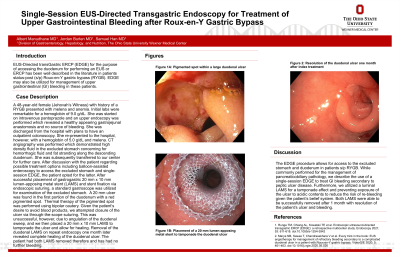Sunday Poster Session
Category: Endoscopy Video Forum
P0376 - Single-Session EUS-Directed Transgastric Endoscopy for Treatment of Upper Gastrointestinal Bleeding After Roux-en-Y Gastric Bypass

.jpg)
Albert Manudhane, MD
The Ohio State University Wexner Medical Center
Columbus, OH
Presenting Author(s)
The Ohio State University Wexner Medical Center, Columbus, OH
Introduction:
EUS-Directed transGastric ERCP (EDGE) for the purpose of accessing the duodenum for performing an ERCP has been well described in the literature in patients status-post (s/p) Roux-en-Y gastric bypass (RYGB). EDGE may also be utilized for treating upper gastrointestinal (GI) bleeding in these patients.
Case Description/Methods:
A 48-year-old female (Jehovah’s Witness) with history of a RYGB presented with melena and anemia. She was started on pantoprazole and upper endoscopy revealed a healthy appearing gastrojejunal anastomosis and no source of bleeding. She was discharged with plans to have an outpatient colonoscopy. She re-presented to the hospital, however, with a hemoglobin of 5.0 g/dL and melena. CT angiography was performed which demonstrated high density fluid in the excluded stomach concerning for hemorrhagic fluid and fat stranding along the descending duodenum. She was subsequently transferred to our center for further care. After discussion with the patient regarding treatment options including balloon-assisted enteroscopy to access the excluded stomach and single-session EDGE, the patient opted for the latter. After successful placement of gastrogastric 20 mm x 10 mm lumen-apposing metal stent (LAMS) and stent fixation via endoscopic suturing, a standard gastroscope was utilized for examination of the excluded stomach. A 20 mm ulcer was found in the first portion of the duodenum with a red pigmented spot. Thermal therapy of the pigmented spot was performed using bipolar cautery. Given the patient’s desire to avoid blood products, we then placed a 20 mm x 10 mm LAMS to reduce the risk of re-bleeding via tamponade of the ulcer and to allow for healing. Removal of the duodenal LAMS on repeat endoscopy one month later revealed complete healing of the duodenal ulcer. The patient had both LAMS removed therefore and has had no further bleeding.
Discussion:
The EDGE procedure allows for access to the excluded stomach and duodenum in patients s/p RYGB. While commonly performed for the management of pancreaticobiliary pathology, we describe the use of a single-session EDGE to treat GI bleeding secondary to peptic ulcer disease. Furthermore, we utilized a luminal LAMS for a tamponade effect and preventing exposure of the ulcer to acidic contents to reduce the risk of re-bleeding given the patient’s belief system. Both LAMS were able to be successfully removed after 1 month with resolution of the patient’s ulcer and bleeding.
Disclosures:
Albert Manudhane, MD, Jordan Burlen, MD, Samuel Han, MD. P0376 - Single-Session EUS-Directed Transgastric Endoscopy for Treatment of Upper Gastrointestinal Bleeding After Roux-en-Y Gastric Bypass, ACG 2023 Annual Scientific Meeting Abstracts. Vancouver, BC, Canada: American College of Gastroenterology.
